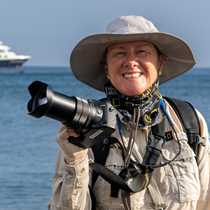San Francisco community & the Amazon River
Early birds out, the air was heavy with moisture. I thought for sure it might rain, but no, the morning turned just about perfect: overcast until late morning, by which time we were on our way home.
But back to the beginning...
The early birds added more species to the bird list such as short-tailed parrots, Tui parakeet, crested woodpeckers, little woodpeckers (and they are!), grayish saltator, bare-necked fruitcrow, umbrellabird, dusky-headed flycatcher, chestnut-bellied seedeater, and black-capped donacobious...to mention just a few.
After breakfast we took our first expedition into the Amazonian rainforest. It is the biggest challenge for me to describe these walks, because there is very little with which a newcomer can compare. Rainforest trails require stepping over roots, fallen branches, holes left by decomposing palm trees hidden by leaves, dips and bumps where water runs off, tremendous spiny tree trunks, humidity in the 90's, low light levels, innumerable shades of green with spots of yellow and red and brown that are flowers, fungus, new or old leaves, lianas, vines going up and vines growing down, strangler figs and melastomes, a beautiful group of plants with exotic veining in the leaves. Add to the mix currents of air that move one leaf a third of the way up but nothing else nearby. My eyes dance from one object to the next, yet have to look down in order not to trip.
One group decided to go the long way around to the village of San Francisco, while the other took a shorter version, stopping by the ship before hitting the village with gifts in hand. They were expecting us, and the educational goodies our guests had brought had been collected beforehand. Our local naturalists got the kids of the community in two long lines (school is out right now for summer holidays), and in an orderly fashion, pencils, pens, notebooks, sharpeners, crayons, markers and postcards were handed out. One two year-old burst into tears, but for what reason I couldn’t figure out. Siblings looked after each other, younger handing to the older their prizes to be looked after and taken home.
Meanwhile the adults did some shopping of some very nice handicrafts...woven bags made of the native “chambira” palm fiber are excellent and long-lasting (my hammock of chambira is 20 years old and still strong!).
Back on board we dove into the showers, and significantly refreshed, met on the top deck as the Delfin II took off downriver for our afternoon to be spent on the mighty Amazon!
After siesta time (still mandatory for all), a few intrepid adventurers went for a celebratory swim in the Amazon! Where the Ucayali and Marañon rivers meet, the combined waters take on the name so well known around the world. One-fifth of the world's fresh water pours out of the Amazon's mouth into the Atlantic Ocean, still almost 4,000 kilometers away from our swimming spot at the head. This evening the Delfin II would start up the Ucayali River, and if followed to the bitter end (only recently confirmed in 2001) would end up at a glacial stream on a snowcapped 5,597 m (18,363 ft) peak called Nevado Mismi in the Peruvian Andes, roughly 160 km (100 mi) west of Lake Titicaca & 700 km (430 mi) southeast of Lima.
Later, the skiffs took off for a trip along the banks before returning on board for a sunset cocktail in honor of our historic and geographically important location. The sky cooperated with reds, oranges and blues before the dark once more took over and we continued on our way. Something different was in store, however: after dinner a night-hike was planned to great success! Flashlights in hand, tarantulas, lizards and fireflies put on a demonstration, while the night sounds filled the imagination with possibilities.




